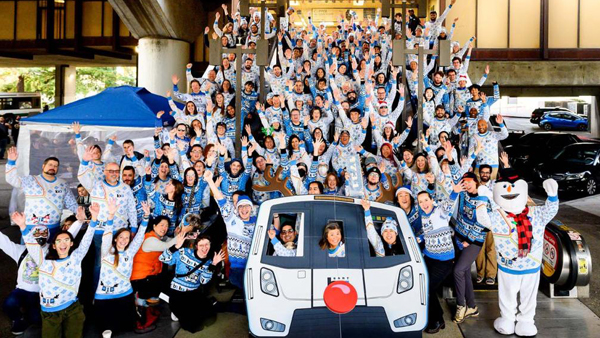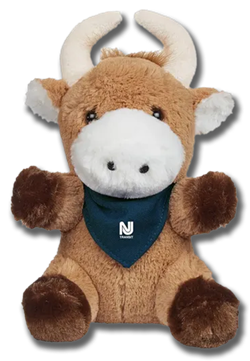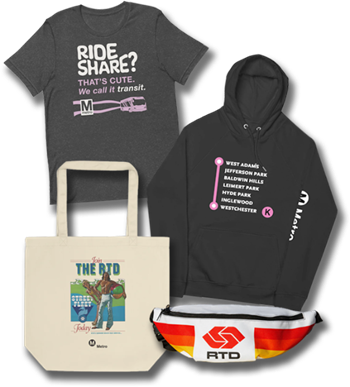Ugly Sweaters, Plush Toys, and Transit Maps
Merchandising won’t pay the bills, but it can be cheeky fun with fans
IN THE PANTHEON of ironic normcore, one ugly Christmas sweater reigns above all others: the BART holiday sweater. You can't get the BART sweater from a vintage store, Urban Outfitters, or your grandma’s closet.
You have to get each year’s new rendition directly from the source: the Bay Area Rapid Transit (BART) District.
BART spends most of its $2.6-billion annual budget on standard transit services, including rolling stock, maintenance, and vehicle operators. But, a tiny piece of BART is also an online retailer, selling an array of items carrying the agency’s logo, and its signature item is the holiday sweater.
Conceived in 2021, the holiday sweater captures San Francisco’s love of irony and kitsch — if not its reverence for the Nativity. They endear Bay Area residents to their region’s semi-beloved, but often criticized, heavy rail system. BART sold more than 3,500 of the 2023 edition.

“Each sweater has gone viral on social media,” said BART spokesperson Alicia Trost. Last year, BART organized its first SweaterFest, in which fans gathered for a group photo in their sweaters — at a BART station, of course. More than 1,000 people participated. (That success inspired rival agency San Francisco Muni to announce its own ugly holiday sweater for 2024.)
BART’s sweaters are among untold numbers of products that are flying off transit agencies’ (mostly virtual) shelves. Precise sales figures are otherwise hard to find, and are often not publicly announced, but many transit agencies are finding serious success in the retail business.
“I don’t believe there’s any board mandate to run a merch shop, but it is definitely in keeping with our branding and marketing overall objectives,” said Jennifer Ashley, social media content manager at Los Angeles Metro.
Some agencies that have thriving retail operations are the very same that have suffered from post-COVID commuting patterns, in which remote work has reduced ridership, threatened budgets, and coincided with increases in vagrancy, violence, and crime on some lines.
Public Awareness
“It’s bringing awareness to the public, especially at times, post-pandemic when we are trying to build ridership back,” said Sarah Meyer, chief customer experience and engagement officer at the Washington (D.C.) Metropolitan Area Transit Authority (WMATA).
 Whereas agencies typically sell just one thing — mobility — their stores sell a dazzling array of items: umbrellas, potholders, holiday ornaments, tote bags, entire lines of clothing — all with logos — and maps. Items for children, such as toy trains, generally sell well. Conversely, agencies often sell historical mementos, such as replica (and sometimes authentic) head signs and tokens, which often appeal to transit enthusiasts, and clothing that uses retired logos and colors.
Whereas agencies typically sell just one thing — mobility — their stores sell a dazzling array of items: umbrellas, potholders, holiday ornaments, tote bags, entire lines of clothing — all with logos — and maps. Items for children, such as toy trains, generally sell well. Conversely, agencies often sell historical mementos, such as replica (and sometimes authentic) head signs and tokens, which often appeal to transit enthusiasts, and clothing that uses retired logos and colors.
“I love a lot of our RTD collection,” said Ashley, referring to Metro’s predecessor agency, the Southern California Rapid Transit District. “I grew up in L.A. in the ‘90s, so that design is very nostalgic for me.”
Many agencies promote seasonal items or items related to events.
BART recently sold anime-inspired merchandise, including train conductor action figures, for FanimeCon in San Jose. WMATA celebrates Washington, D.C.’s, annual Cherry Blossom Festival with a profusion of floral-themed items. Almost every agency with merchandise promoted rainbow-themed items for Pride Month, in June, and many commemorated Bike Month in May.
Last year, WMATA managed to celebrate its 1970s architecture and poke fun at itself all at the same time with a t-shirt reading, “Brutiful,” referring to the system’s cast concrete stations. It happens to be their best-selling item.
“I think it has something to do with this hyper-local, insider joke that we all sort of get,” said Meyer. “Whereas the tourists might buy the Metro map T-shirt.”
Sometimes, merchandise can be a matter of taking advantage of media attention. NJ TRANSIT quickly rolled out a plush toy in homage to Ricardo the Bull, an actual longhorn steer who became a viral sensation after he got stuck on the tracks at Newark Penn Station in December. A portion of proceeds from each $20 toy went directly to the Skylands Animal Sanctuary & Rescue, where Ricardo was taken after he was captured. In February, NJ TRANSIT presented a $10,000 check to the sanctuary, which rehabilitates and cares for farm animals that have escaped slaughter.
Types of customers and their motivations vary wildly.
 For some, wearing or otherwise displaying transit-themed clothing or mementos ties into broader feelings of civic pride or identification with place — even if they rarely ride transit.
For some, wearing or otherwise displaying transit-themed clothing or mementos ties into broader feelings of civic pride or identification with place — even if they rarely ride transit.
“Even if you’re not riding transit, it’s important to see fans and customers walking around the city,” said Meyer.
For others, the train is the thing. They get a kick out of transit generally and want to spread the word. In many cases, tourists pick up transit merchandise to memorialize a trip in a more substantial way than they would with a generic airport-style souvenir.
In many cases, interest is driven by social media, where agencies have developed personas that can seem disconnected from the actual business of moving people around.
“Agencies are starting to use social media in really fun ways; there’s a cheekiness,” said Darren Kornblut, who runs Transit Gifts, an e-commerce platform that runs online stores for many agencies, including Chicago Transit Authority and WMATA. “Nobody likes it when their trains are late; nobody likes when there’s a problem with rolling stock. But people love their communities. I think the agencies have tapped into the sunny side in all of it.”
Publicity is Publicity
For agencies, the reasons why people purchase merchandise might not matter — publicity is publicity.
“Every time we sell a T-shirt or anything that you wear … all of those people are moving around the Bay Area wearing our logo and brand. We definitely think it helps drive ridership,” said Trost.
 For all the goodwill that merchandise might generate, there’s one thing that agencies should not expect to come of stores: big profits. While many stores are profitable enough to cover their own costs, the revenue they bring in is negligible in the context of operating budgets that run in the billions of dollars.
For all the goodwill that merchandise might generate, there’s one thing that agencies should not expect to come of stores: big profits. While many stores are profitable enough to cover their own costs, the revenue they bring in is negligible in the context of operating budgets that run in the billions of dollars.
“Don’t go into a gift program with the expectation that it’s going to pay for rolling stock,” said Kornblut.
And, yet, most, if not all, transit agencies rely on public subsidies. A well-run transit store may be one of the few — if not the only — profitable business divisions in an agency.
“We’re not really a store. It’s not even close to our main business,” said Ashley, adding, however, that “it is one of the few revenue-generating projects at Metro.”
In most cases, these margins rely on low, or nonexistent, overhead. Like many other online retailers, online transit stores produce and ship merchandise on-demand, so they do not have to bear the expense of carrying inventories or — ironically — transporting orders themselves.
“The vendor network that exists now allows us to do the hyper-local merchandise on demand that you could not do a few years ago,” said Kornblut.
Trost cautioned that agencies need to be mindful of the quality of the merchandise they are selling, noting, “It’s different from the giveaways and tchotchkes.”
Kornblut agrees.
“The main focus of these programs is to develop museum-store quality merchandise, a click or two above promotional merchandise,” he said.
Even with semi-automated sales and fulfillment, agencies still must hire humans to oversee their merchandise programs. In most cases, this job falls to a member of an agency’s marketing team and is, usually, only part of that person’s responsibilities.
“The current iteration of the store is completely a side-hustle for a group of employees who think it’s a cool project,” said Ashley.
While sales of transit merchandise may be on the rise, the unavoidable fact is that transit ridership in the United States remains stagnant, due in part to competition from ride-hailing services. As of last year, transit ridership was 74 percent of 2019 levels nationwide. But, transit agencies may yet be winning hearts, minds, and bodies.
“Public transit agencies are fighting for relevance and ridership,” said Meyer. “I don’t see people wearing Uber T-shirts very often.”
Josh Stephens is a freelance writer based in Los Angeles.